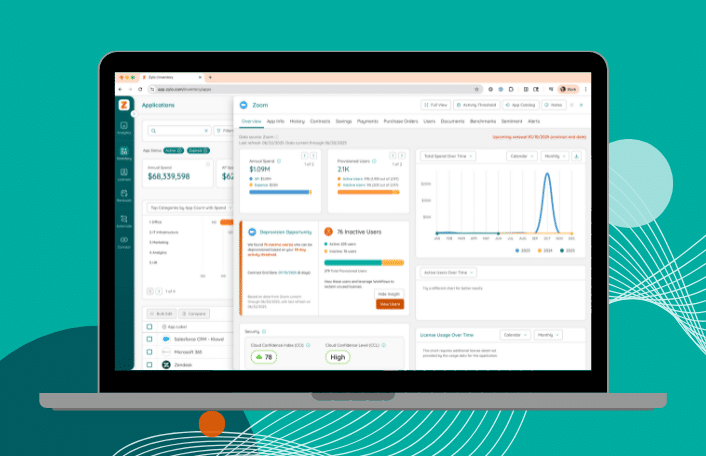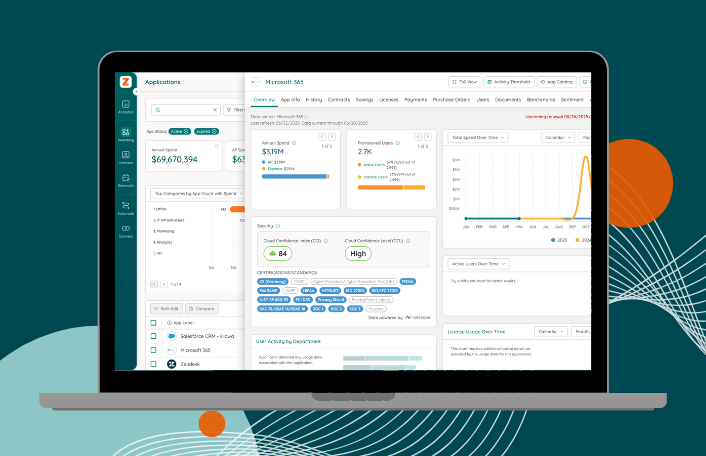
The IT & SAM Leader’s Guide to Smarter Zoom License Management
Table of Contents ToggleWhat SaaS Means for Your Software Asset Management...
Back
Back
Search for Keywords...
Blog

Table of Contents
SaaS has changed the way software is purchased. And now Zylo is changing the way software is managed. According to a past Gartner study, IT spending on enterprise applications was expected to grow at a 8.6% rate from 2015 to 2020. During this same period, SaaS growth was predicted to reach $76B by 2020. Today, Gartner expects it to exceed $299B. Strong SaaS revenue growth and corresponding client expenditure mean that IT leaders can no longer ignore the need to manage SaaS costs carefully.”

CapEx versus OpEx has been a focus for IT purchases in the past, and it’s a strategic part of traditional software asset management tools. But with the increase in SaaS application purchases at the enterprise, CapEx doesn’t exist with SaaS technology subscriptions.
This shift can have a number of benefits, but now the CIO and CFO have to manage a greater amount of the OpEx recurring costs without an effective tool to measure and optimize it. That tool is SaaS Asset Management software.
But before we dive into why, let’s take a look at the problem and how managing SaaS differs from traditional on-premise software.
Many organizations don’t have strict procedures for purchasing SaaS applications or requesting access to licenses of existing SaaS applications. Especially since it’s so easy to purchase, and IT and Finance are not always involved with many of the lower-cost solutions. Discovering and gaining visibility into all of the SaaS applications being purchased across the entire business, large and small, is often an arduous task and difficult to keep up to date.
Many teams are missing a huge opportunity to corral one of the fastest-growing expense categories in their organization. That can only be accomplished with real-time data to showcase what SaaS applications are purchased throughout the organization and user data to track provisioned users and if they are actually using the application regularly.
This means that departments across the organization are acquiring new SaaS applications (sometimes with IT and other times without IT knowing), but often aren’t following through to cancel subscriptions or properly manage which team members have access to each application as teams and needs change over time.
SaaS is often viewed as a solution to reduce complexity around software compliance and audit needs, which is partially true. But shifting gears to SaaS application usage monitoring and right-sizing licenses is more important than ever, not to mention complicated to execute well.
Actively tracking SaaS utilization is important because without knowing how services are being used across an organization, it’s impossible to quantify the value being delivered from each SaaS application.
It’s time for enterprises to move away from the sole focus on software license compliance and focus more on delivering cost savings and business value. SaaS optimization is an area of immediate impact that most organizations are missing today on both the spend and utilization fronts.
IT and Finance teams can identify cost savings opportunities by uncovering unused or overlapping subscriptions to SaaS applications or consolidating multi-channel spend for the same SaaS application. Getting real-time utilization provides the metrics to rightsize licenses and ensure upcoming renewals are negotiated for the number of licenses needed.
But, how? With SaaS Asset Management software.
Technology is accelerating businesses, and the shift to the Cloud and SaaS is driving change faster than ever. As a result, technology spend and value are on the agenda in more and more executive meetings. Having one system of record to accurately report SaaS spend, active utilization and employee feedback is invaluable to making the best financial decisions for the organization.
SaaS is not purchased or used like traditional software and cannot be managed like it.
What should you be thinking about as you being your SaaS Management journey? Review the three questions you should be asking yourself before jumping in here, and learn how to build your business case here.
ABOUT THE AUTHOR

Eric Christopher
Eric Christopher is CEO and Co-Founder of Zylo, the leading SaaS management platform. After 14 years of buying and selling software, Eric knew there had to be a better way to manage cloud applications within a company. Eric started his career in sales at ExactTarget from 2002 to 2010. He spent the next six years in Chicago leading sales teams at Shoutlet and Sprout Social Inc., and founded Zylo in 2016.

Table of Contents ToggleWhat SaaS Means for Your Software Asset Management...

Table of Contents ToggleHow FinOps Teams Commonly Understand SaaS—and What’s MissingSaaS...

Table of Contents ToggleWhat Is an E-Commerce Tech Stack?Why Your E-commerce...

Table of Contents ToggleWhat SaaS Means for Your Software Asset Management...
| Cookie | Duration | Description |
|---|---|---|
| cookielawinfo-checkbox-analytics | 11 months | This cookie is set by GDPR Cookie Consent plugin. The cookie is used to store the user consent for the cookies in the category "Analytics". |
| cookielawinfo-checkbox-functional | 11 months | The cookie is set by GDPR cookie consent to record the user consent for the cookies in the category "Functional". |
| cookielawinfo-checkbox-necessary | 11 months | This cookie is set by GDPR Cookie Consent plugin. The cookies is used to store the user consent for the cookies in the category "Necessary". |
| cookielawinfo-checkbox-others | 11 months | This cookie is set by GDPR Cookie Consent plugin. The cookie is used to store the user consent for the cookies in the category "Other. |
| cookielawinfo-checkbox-performance | 11 months | This cookie is set by GDPR Cookie Consent plugin. The cookie is used to store the user consent for the cookies in the category "Performance". |
| viewed_cookie_policy | 11 months | The cookie is set by the GDPR Cookie Consent plugin and is used to store whether or not user has consented to the use of cookies. It does not store any personal data. |
